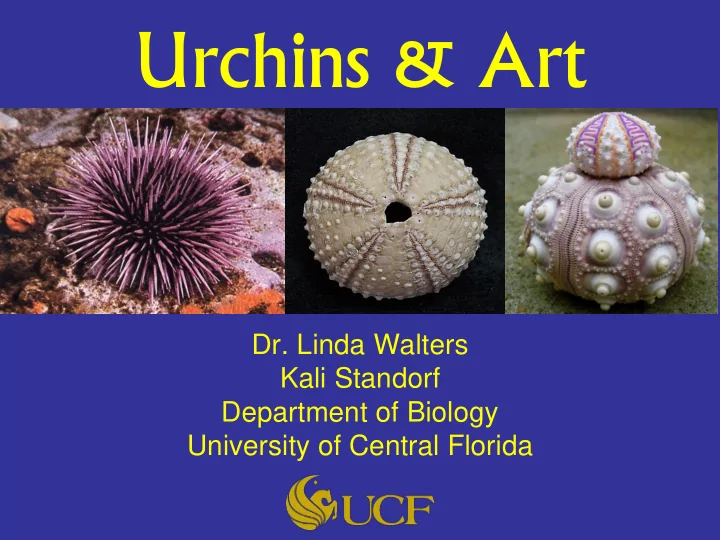

Urchins & Art Dr. Linda Walters Kali Standorf Department of Biology University of Central Florida
Urchin Art
What is a sea urchin? • Echinoderms (~700 species) – Radial symmetry – Water vascular system – Locomotion: tube feet – Found in shallows to deep sea
More urchin info. Reproduction – Separate sexes – Spawn gametes into water column – 2 stage life-cycle (swimming larva + benthic adult)
What do urchins eat? What eats urchins?
Who eats sea urchins?
Marine Conservation Biology Coral Reef Ecology Oyster Biology and Restoration Invasive Species
Ideal Coral Reef....
Reality....
? Phase Shift How did this happen? 1) Loss of commercially important fish species 2) Anthropogenic nutrient enrichment 3) Increase in frequency/intensity of storms 4) Urchins
Diadema Die-Off in Caribbean • Keystone herbivore (100/m 2 ) • All seaweed consumed • Reefs: Corals dominated • Near-extinction in early 1980s • Reefs: Algae dominated • Since 2000 , Diadema returning – Where? – Impact on corals? – Genetic bottleneck?
Return to St. Thomas, USVI • 1.6 ± 0.1/m 2 (2006-2009) • Nursery area: Airport runway extension with 7 – 9/m 2 up to 34/m 2
Can the return of Diadema to Caribbean waters shift us back to coral dominance? Diadema Coral- Algal- Porites astreoides Urchin Interactions Dictyota menstrualis
Porites astreoides: Larval Collection 1 mm
Field recruitment experiments (FL, USVI) •Treatments: control, plastic mimic, alga • 100 larvae (n = 10) **Coral settlement significantly reduced if Dictyota present**
Diadema Herbivory on Dictyota • Consumed 30 – 85% biomass overnight • Each urchin generated 8 – 53 fragments • Fragment Viability: 61% • Reattach < 24 hr
Are there enough urchins to consume enough algae to clear areas for corals to settle and grow? Could the urchins themselves damage coral spat when foraging?
Coral-Algal- Diadema Interactions • 5 coral spat/tile • Treatments: control, mimic, algae with/without urchin • Urchins feed overnight Dictyota • Foraging on Dictyota 5 4 * killed 50% coral spat Survival 3 2 • Foraging on 3 other 1 algae had no effect 0 A+U A-U M+U M-U C+U C-U Treatment
Genetic Bottleneck? Kali’s project • How much genetic diversity is there in these returning populations? – Bottleneck (limited DNA diversity)? – Mixing from ocean currents? – Molecular techniques to look at DNA from 8 populations – 3 islands, both juveniles and adults
Recommend
More recommend